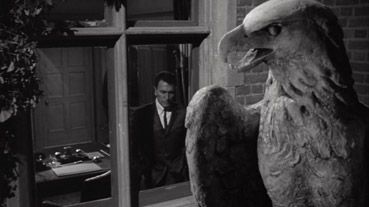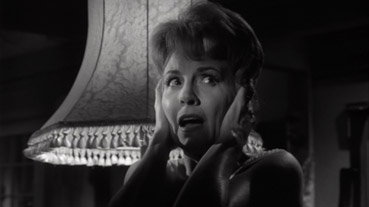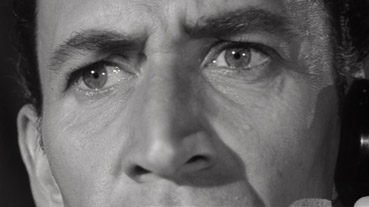|
Fans
of the ghost stories of M.R. James – and what serious reader
of horror fiction isn't? – will be well aware of his favourite
plot, which introduces us to a sceptic who is later prompted
to reconsider his unbelief when directly exposed to some
terrifying supernatural event or apparition. It's at the
core of many of his stories and the two most celebrated
film adaptations of his work, Night of the Demon
(1957) and Whistle and
I'll Come to You (1968).
Night
of the Eagle is certainly in the M.R. James mould
but was actually based on the novel Conjure Wife
by Fritz Leiber Jr., a book I confess to not having read and whose adaptation here I am thus unable to testify the accuracy of. Whether Leiber
himself was influenced by James I've been unable to confirm,
but various sources note the influence of both H.P. Lovecraft
and Robert Graves on his earlier work and Carl Jung on
the later, and a recurring theme in his stories involves paranormal activity in modern urban settings rather than
the gothic isolation of more classic horror fiction. Conjure
Wife has in fact seen three film adaptations, with
Night of the Eagle preceded by the 1944
Weird Woman and followed in 1980 by a more light-hearted
take on the story, Witches Brew.*

Night
of the Eagle takes its subject seriously from the
start and wastes no time establishing its credentials – the
very first words of dialogue are "I...do...not...believe!"
emphatically stated by professor Norman Taylor of the Hempnell
Medical College as he writes them large across the blackboard.
These four simple words, he informs his students, are the
best defence against all of the superstitious nonsense out
there that gets in the way of hard science. He's right,
of course, but this is not real life but a horror film, and
we thus know he's setting himself up for a dramatic about-turn
later on.
At
this point, things are going swimmingly for Norman. His students
get the best grades in the school and it looks like he's
up for promotion. He has a nice house, a sporty car, and
his wife Tansy adores him. Not everything is picture-book
perfect, however. One of his students, Margaret Abbott, has a serious
crush on him, making her underachieving boyfriend Fred Jennings seriously
jealous. But none of this bothers Norman, who responds by putting Margaret
in her place and ordering Fred to pull his socks up. There's
also some jealousy amongst the wives of the other professors
– after all, Norman is the new kid on the block and their
husbands are surely more deserving of the promotion than
him. But they all get together every Friday evening and
play bridge nonetheless, a cosy and pleasant little academic
community.
Following the latest bridge evening, however, Tansy seems
unusually agitated. She's searching the living room for
something, a shopping list with a phone number on she claims,
but her urgency and determination suggest it's something
more valuable. The only thing is, she's looking for it in places
that it couldn't possibly be. When
she later finds what she is seeking she immediately
burns it. What is it? Ah, you'll have to see for yourself.
Norman,
meanwhile, is upstairs looking for his pyjamas, but the
drawer in which the clean ones are stored is jammed. Further
investigation reveals a small jar containing a dead spider.
A BIG dead spider. As you might imagine, he has a few questions
for his wife. He has a lot more the next day when he discovers
that this is not the only strange artifact in her possession.
When pressed, she reveals that it all stems back to a
trip they took to Jamaica and a witch doctor they met there,
who brought a young girl back from the dead before their
very eyes, or at least that's how she remembers it. She's
been practicing witchcraft for years, she tells him – why
else did he think he was leading such a charmed life? Outraged
by his wife's devotion to such superstitious nonsense, Norman
destroys every last magical object, despite his wife's pleas.
"I will not be responsible for what happens to us if
you make me give up my protection!" she cries. There's
clearly more than career enhancement going on here.

Now if any or all of this sounds a little hokey then let
me assure you that it never plays that
way. Right from the start, director Sidney Hayers treats
the story as seriously as he would any straight drama and
has clearly instructed the cast to do likewise. In a compelling
central performance, Peter Wyngarde completely sells Norman
as a no-nonsense, self-assured sceptic who is determined to confront
and combat superstition wherever he finds it, and his
battle of wills with his wife (the equally convincing Janet
Blair) is both tense and believable. In that reverse-belief
approach horror movie fans have to apply to their beloved
genre, you know that he's talking perfect sense, but also
that he's wrong. Watching it with my girlfriend I was amused
when she yelled at the screen, "Why do men never listen?"
No comment.
From this point on, Norman's good luck all but evaporates
in a nicely judged mix of earthly problems and possibly
supernatural forces. It's in the latter that the film really
flexes its cinematic muscle, especially in an excellent
sequence where the house comes under assualt from unseen forces, their power and malevolence suggested entirely through the use of lighting, camerawork and sound effects. It's a scene
that scared me witless when I first saw it years ago, and
even all these years later, with umpteen horror films under
my belt, it still sent
chills up my spine. There are plenty of shots suggesting
the form that this force takes – the real surprise is how
convincing it proves to be when we actually get
to see it.
This proves to be Night of the Eagle's trump card,
that it sucessfully sells its witchcraft as real and its consequences as genuinely
threatening. It's a rare trick managed only by a select
few – that two others are Night of the Demon
and The Devil Rides Out (1968) is only
appropriate, given that Night of the Eagle
bears a structural and visual resemblance to the former
(the similarity in title is surely no coincidence) and has
the latter's breathless, incident-packed pace. A tight,
intelligent script (co-written by genre maestro Richard
Matheson, who also wrote the screenplay for The Devil Rides Out), Wyngarde's performance and Hayers' assured handling
are all crucial here, with Norman's transformation from hardened
sceptic to desperate believer an object lesson in how to
make such a switch of belief convincing. Technically the
film outshines its doubtless limited budget via Reginald
Wyer's fine monochrome cinematography, Ralph Sheldon's fat-free
editing, and some startlingly good special effects – there's
a road crash here that's as alarming as any I've seen, despite being created largely through what I presume is back-projection.

I
have fond memories of my late night discovery of Night
of the Eagle many years ago, and though initially
excited by the news of the DVD release, I was worried that
it would not measure up to my recollection. I'm happy to
report that it did. It's a worthy first release (along with
the 1960 Circus
of Horrors, also directed by Sidney Hayers)
for Optimum's new Horror Classics collection, and will hopefully
reach a wider audience of horror fans who didn't realise
that, once upon a time, we British could also make classy,
intelligent genre films that would stand the test of time.
The
picture is framed 1.78:1 and although the IMDb carries 1.85:1
as the correct aspect ratio, which seems more likely, although 1.66:1 was also a popular aspect ratio of the time. Certainly the framing
here looks correct and never feels cropped in any direction.
Although not of Criterion-style sharpness, the anamorphic
transfer is nonetheless a very respectable job, with good
detail and a very nice contrast range. Blacks appear solid
throughout and dust spots are rare.
The
Dolby 2.0 mono track is clear and free of distortion, although
the dynamic range is obviously a little restricted due to
the film's age.
None.
This is a film-only disc, but that's reflected in the budget
price.
This
is a good month for classy 1960s British horror, with Redemption's
recent release of City
of the Dead now joined by two more fine but
little seen works, the first releases of a promising-looking new label
from Optimum. All three films are strong examples of their
craft and deserve a place in any self-respecting horror
fan's collection. But you don't have to be a genre devotee
to appreciate an intelligent, well made chiller, and if
that appeals, then Night of the Eagle certainly
fits the bill.
* My
sincere thanks to Pearce Duncan for pointing out this glaring
ommission in my original review.
|